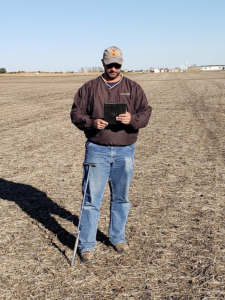Top 3 Ways Farmers Win with Trimble Ag Software
October 29, 2018
Crop advisors working with farmers who manage their operations with Trimble Ag Software have an interesting story to tell. Many share reports of financial and time savings by farmer clients that are tied directly to their farm management software. We wanted to share some of our favorite precision ag software benefits seen by growers over the past year.

Benefit #1 – Yield and Environmental Gains
As a Van Wall Equipment agronomist working with about 15 farmer customers near Ankeny, Iowa, Todd Farver says one of the most rewarding parts of the job is when his farmer customers get a full grasp of the bottom-line impact of making data-driven decisions.
For example, one of Farver’s customers experienced a significant increase in yields on a particular field that had always been problematic. Five years ago it was one of the farm’s lowest-producing fields, yielding about 185-bushel corn on average. Now, it’s reaching 240-bushel corn.
How did this happen? “Before he was flat-rating everything, but now we’re planting 26,000 plants per acre in one zone, and then 37,000 in the better-producing zones,” Farver says. “This is the difference it’s making, and this is why I explain to people that we are putting every seed in the best possible position to be successful.”
Farver gets excited when he recounts his clients’ big wins, and it’s easy to see why. As a passionate believer in precision management, Farver uses Trimble Ag Software’s Advisor Prime platform to plan, manage, and execute strategies to treat each zone in each of his clients’ fields according to its unique needs. The end result? Client profits go up, the risk of over-application goes down, which benefits the environment, and Farver’s day-to-day management of complex prescriptions for countless fields and productivity zones becomes streamlined.
Here’s another example: Farver uses the Crop Health Imagery feature to monitor yield goals for his clients, in the context of local weather impacts. “I can see this field actually got two inches more rain that these other fields and it looks like it will keep getting more,” Farver explained. “When this happens, I am going to put an extra application of nitrogen down where I got more rain, but I won’t on the other fields because less nitrogen will be leaching out. It’s a win-win.”
Benefit #2 – ROI Gains
Every time Farver pulls into a new farmyard to talk about his VRT program, he hears the same question: ‘If I do this, how can I be sure of my ROI?’ For his client pulling in 240-bushel corn mentioned above, the proof is clear. But new growers dipping their toes into precision agriculture take more convincing. Farver takes a big-picture view by looking at what the farmer is currently doing, and then compares that to a VR program that would be created and managed by Farver, with the help of Advisor Prime.
“I explain how I can help them grow their business as a farmer,” Farver said. “I’m going to help them make more money on the same amount of acres they’re currently farming.” While it varies for each farm, Farver typically incorporates three to five different productivity zones into his precision ag plan for each farm. “When they see this, that’s where we’re really able to get down to the acre with them and say, ‘Why would you want to treat this land the same as that land when you can see the differences? Why would you throw that money away?’ If they ask me about all the free services out there today, I tell them yes, I’m not free. But free agronomy is not going to be good agronomy.”
Benefit #3 – VRT Gains
Similar benefits are being reported north of the border. Matt Maess, a crop advisor in North Central Saskatchewan, recently discovered how to leverage his farm management software platform to create variable-rate fungicide maps for his farmer customers, and the payoffs were tangible.
Last year Maess was talking to a client who had been pitched several times by a company that provided satellite imagery of crops in the area. Maess listened to the grower as he explained how this company promised its imagery would provide the exact information the farmer would need to do VR fungicide, and clock significant savings along the way.
Given his familiarity with Trimble Ag Software, Maess was sure that one of its popular features, Crop Health Imagery, could achieve the same goal — without going to an outside source. Maess created the two-zone map using the zone-creation feature in Advisor Prime. Once he created the VR maps, the corresponding shapefiles exported seamlessly into his clients’ Viper Pro and JD 2600 sprayers. The process was simple, and Maess knew he now had an additional service to offer to current and future clients. “As crop advisors, we can go into the software and create zone maps for our clients out of any map that gets put into the system,” Maess explained. “Then we can use any of these to create a map for VR fungicide.”
According to Maess, the VR maps and strategy reduced his client’s overall fungicide cost by a third — which for his clients in Canada would mean $14 an acre, down from $21. For canola, the savings is 30 percent, he said. Pretty impressive results!
Click here for more information on how you can help farmers understand the benefits of Trimble Ag Software.
